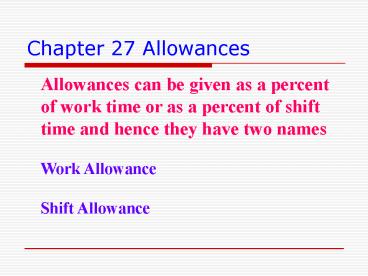Chapter 27 Allowances PowerPoint PPT Presentation
1 / 17
Title: Chapter 27 Allowances
1
Chapter 27 Allowances
Allowances can be given as a percent of work time
or as a percent of shift time and hence they have
two names Work Allowance Shift Allowance
2
Allowance Application
- Allowance is basically some additional time for
personal needs (drink water, go to the restroom,
fatigue and delays) - Standard time Normal Time Allowances
- Shift allowance Allowance time / Standard time
- Work allowance Allowance time / Normal time
- This clearly shows that work allowance is a
little bigger value than shift allowance.
3
Allowances
- Normal Time Allowances Standard Time
- Allowances are the interruptions that occur
during the typical working day - personal - for personal needs
- fatigue - for rest
- delay - reasons beyond his/her control
- Should be applied separately from the rating
4
Allowance vs. Pace
- Included in High Task
- are more challenging
- types of work
- 100 may be feasible
- with easy (low-task)
- type work
Performance,
5
Pace Multiplier
- If the job is considered to be low-task, then
normal work time can be used as is (at 100) - If the job is considered to be high-task, or
difficult for the general population, then normal
work time is first multiplied by a pace value
(110, 120, etc.)
6
Personal Allowance
- Include going to restroom, blowing your nose,
making personal phone calls, etc. - Can be determined by making all-day time studies
or work sampling - Many organizations have standard break periods
- Some firms also give out special allowance for
clean ups after operations, travel allowance etc.
7
Personal Allowances (cont.)
- There is no scientific basis for finding out
personal allowances. It generally depends on
working conditions. - For low-task work, usually 2 to 5 per day is
used - For high-task work, more than 5 is used, esp. in
unfavorable (hot, humid) settings
8
Fatigue Allowance
- Can be mental or physical fatigue
- Much more prevalent in hot, humid settings
- Is less a factor with automation, and with
shorter working days - Can be done by giving organized rest periods
9
Fatigue Allowance
- (Tables on pg. 531-535)
- Physical
- This has four categories.
- Material handling (considers local or whole body
load) - Short cycle (lack of recovery time)
- Posture of static load(standing, squatting,
crouching) - Restrictive clothing (heavy weight of gloves,
breathing - apparatus etc)
10
Example of Physical Fatigue
From a British consulting firm As reported by the
International Labor Organization
See Table 27.4 for conversion of points to
percent allowances
11
Fatigue Allowance
- Mental Allowance
- a) Concentration/anxiety
- b) Monotony
- Environmental Allowance
- a) Climate
- b) Dust, dirt, fumes
- c) Noise / Vibration
- d) Visual (eg., 0 points for normal work,
ranging to 14 points for engraving using an
eyeglass)
12
Delay Allowance
- Can be avoidable or unavoidable
- Does assume that machinery is kept in repair
- Due to tool breakage, interruptions by
supervisors, minor adjustments, etc. - Non-cyclic elements that occur as part of the job
are not to be treated as delays - Can be determined by TS or work sampling
13
Applying the Allowances
- Personal time is applied as a percentage of
normal time it affects both operator and machine
time - Fatigue can be applied as a percentage it
affects only operator time - Delays are applied as a percentage it may be
applied as machine-time delay only
14
Example
- Assume that a consistent performance time of 0.80
minutes was measured - A rating factor of 110 was assigned
- normal time 0.80 min. 110/100 0.88 min
- Assume an allowance of 5
- standard time 0.88 min. 100/95 0.926 min
15
Clarification
- Note that the calculation could also be done
- Selected time 80 min.
- Rating factor 110
- Allowance 5
- Normal time 80110/1000.88 min.
- Std. Time0.88(.880.05)0.924 min. OR
- Std. Time0.88 1.050.924 min.
- This method is INCORRECT!
16
Clarification (cont.)
- By stating a 5 allowance, it is understood that
24 minutes per 8-hour day are to be spent on
non-work activities. - Then during a shift (480 - 24) 456 min. are
available for work. - If the normal time is 0.88 minutes, this means
(456/0.88)518 pieces/shift - Therefore (480/518) 0.926 min./piece
17
Creating Allowance Tables
- Setting allowance standards tends to be a
somewhat political job - Reference tables can be created and then applied
fairly to affected jobs - See curve fitting and reference tables in
Chapters 27 and 30

